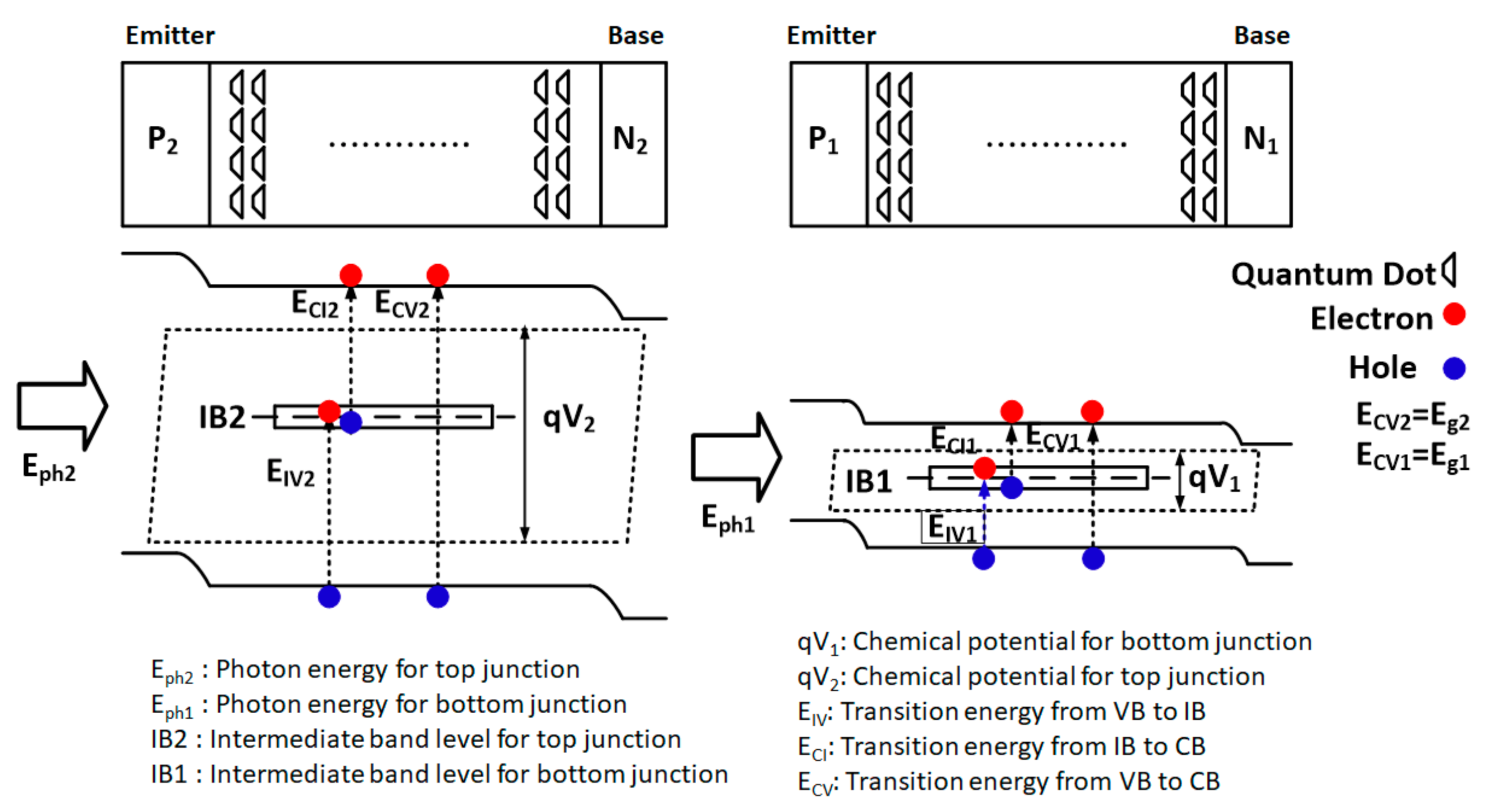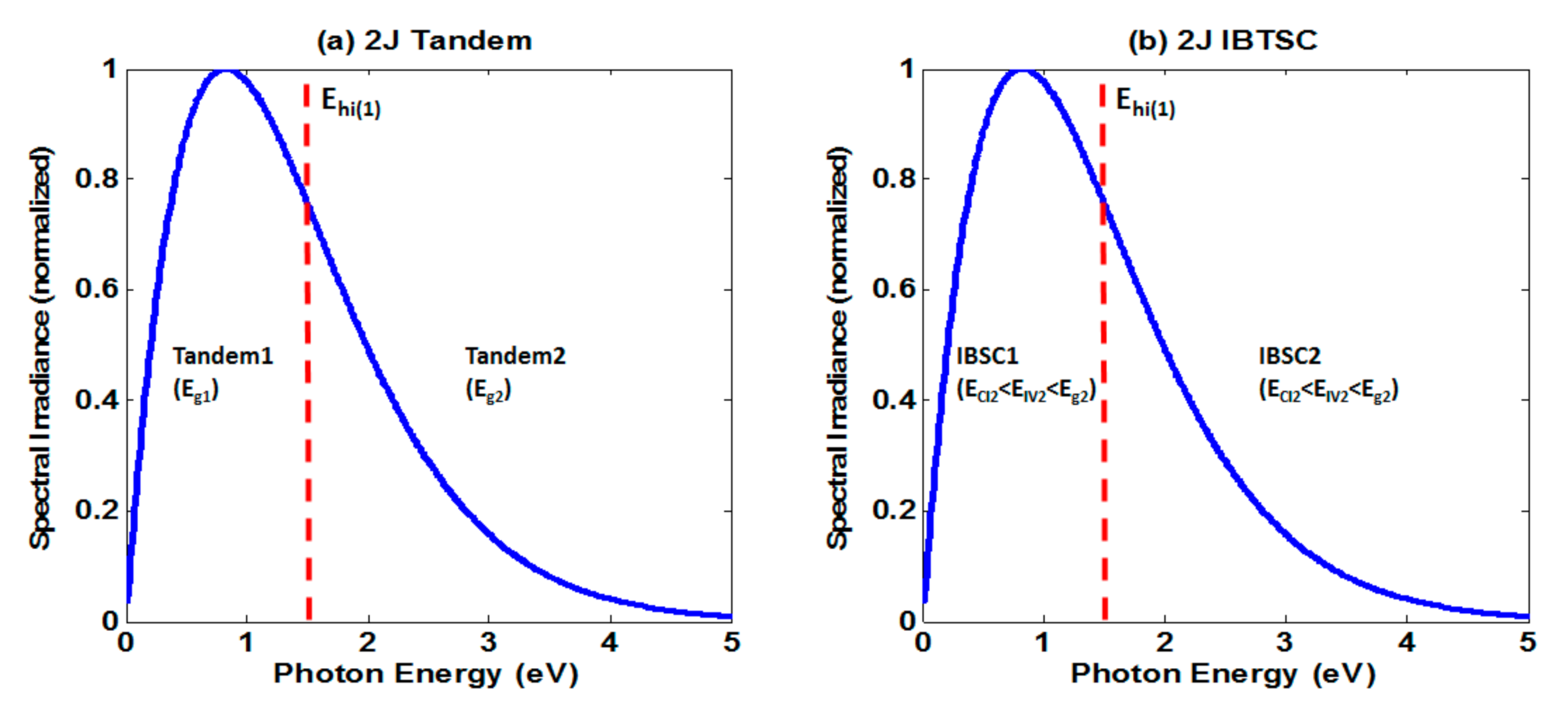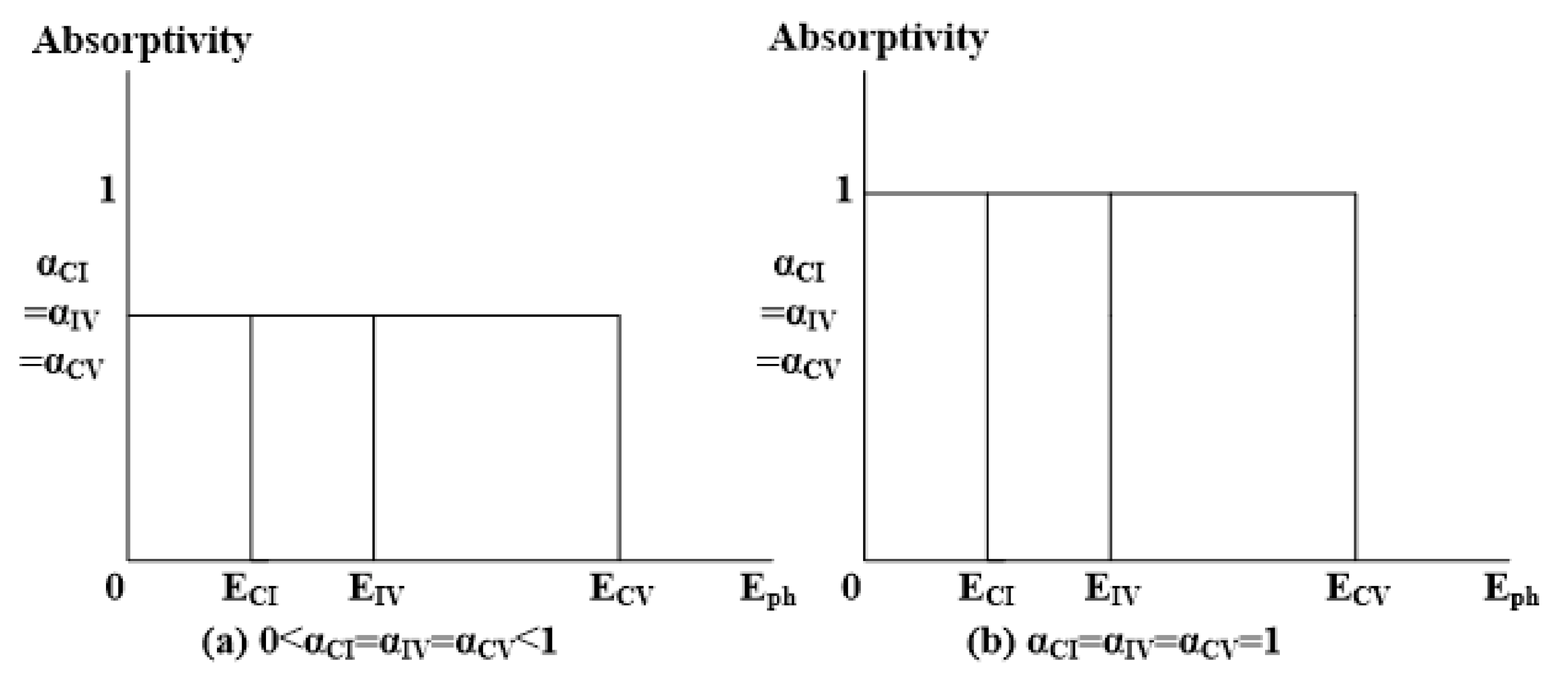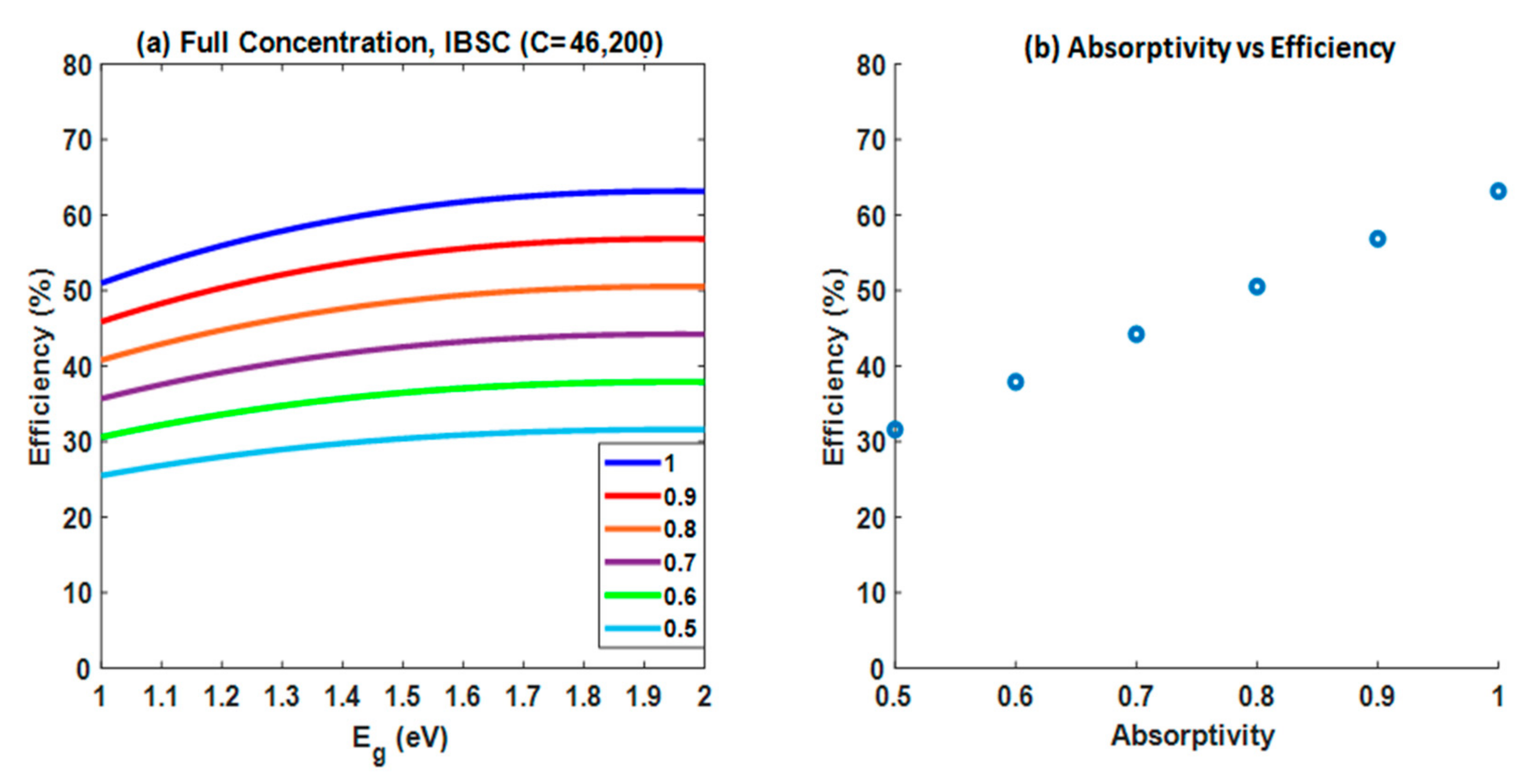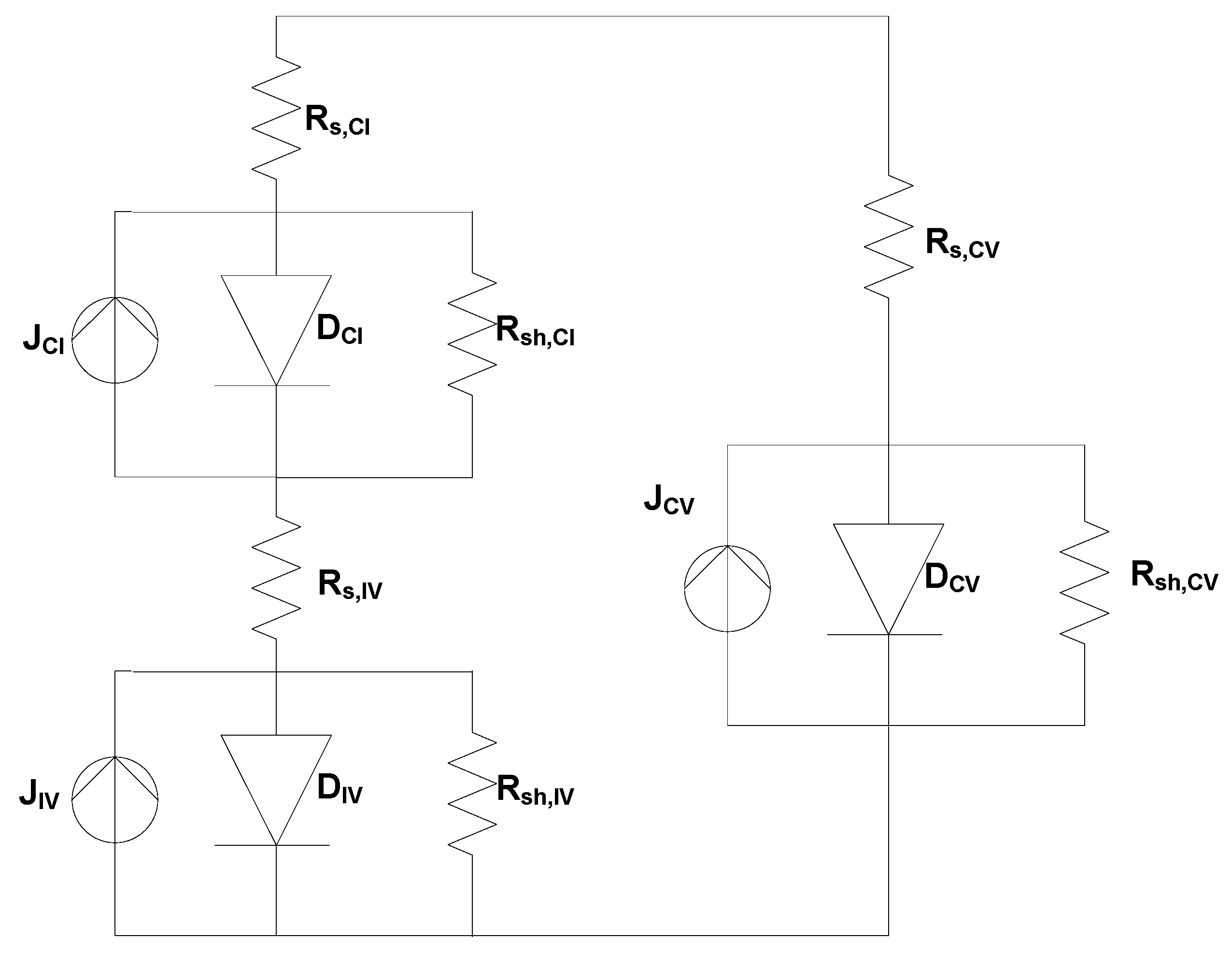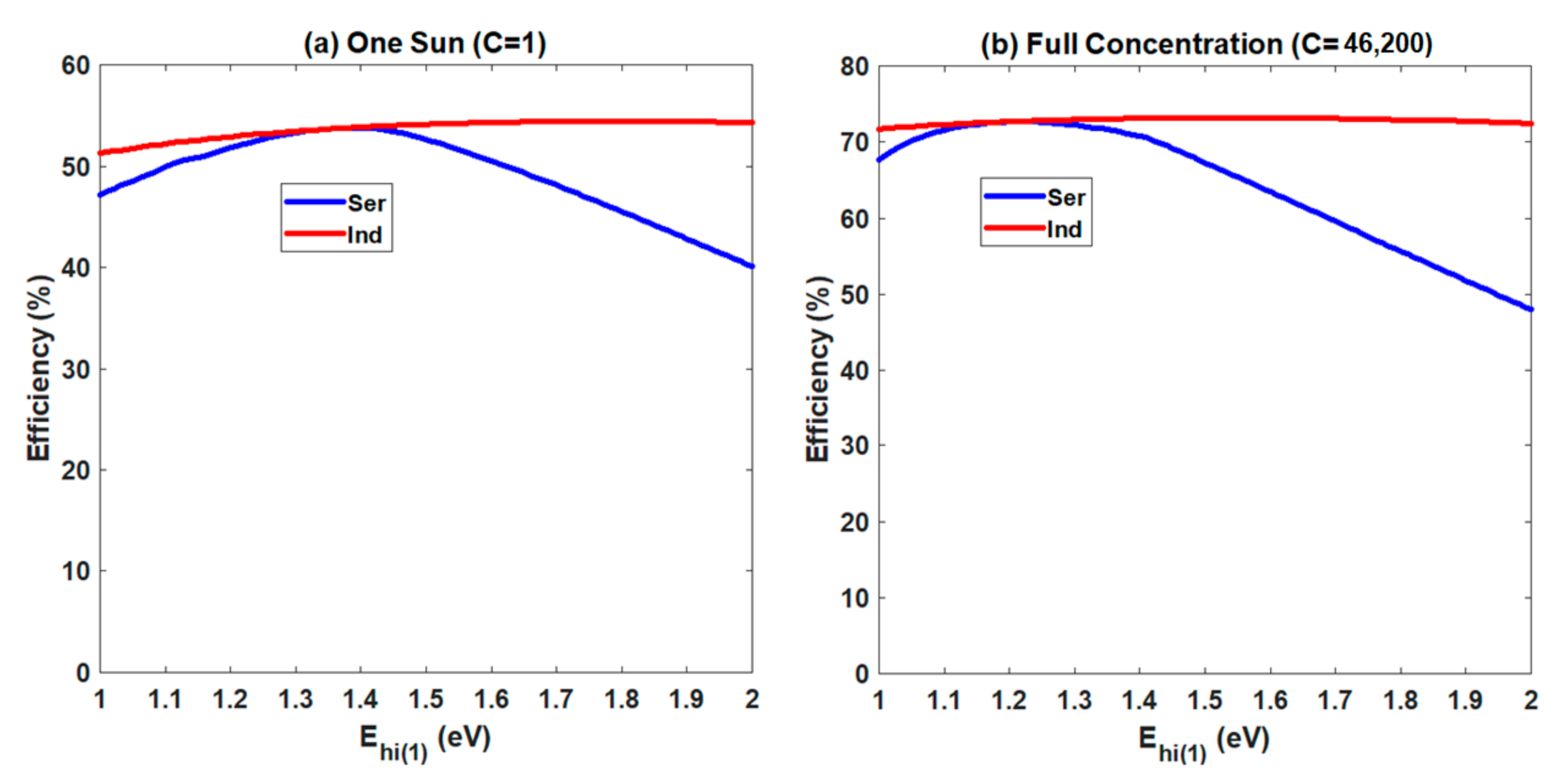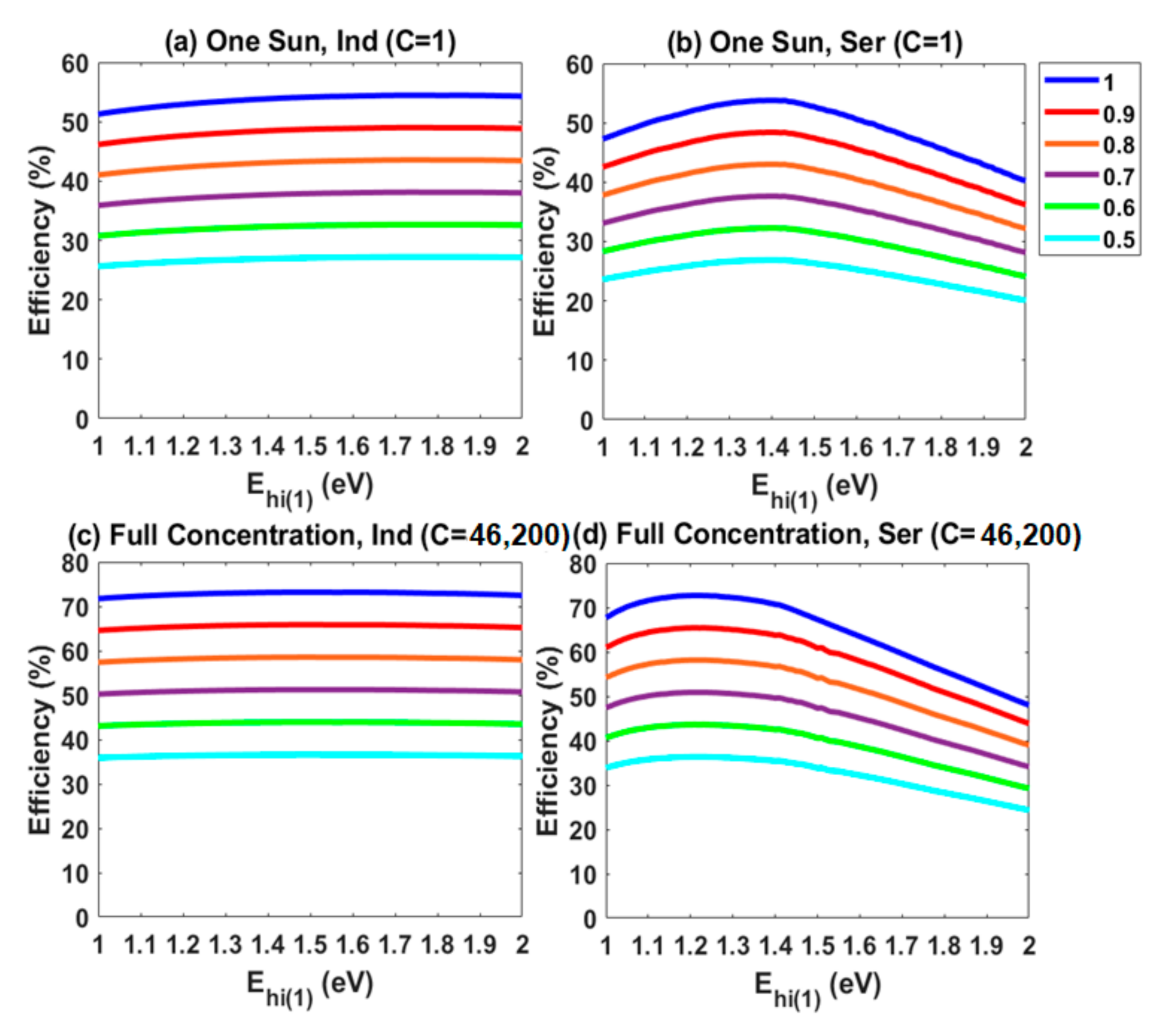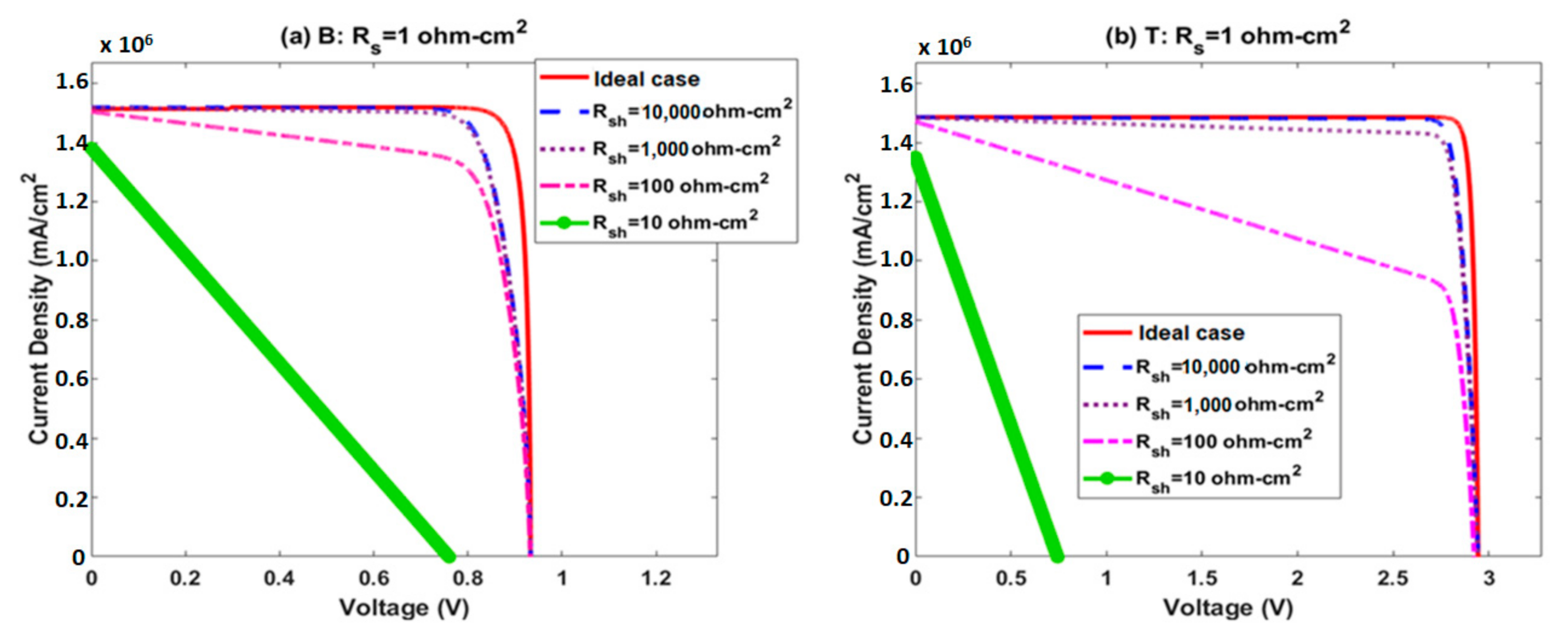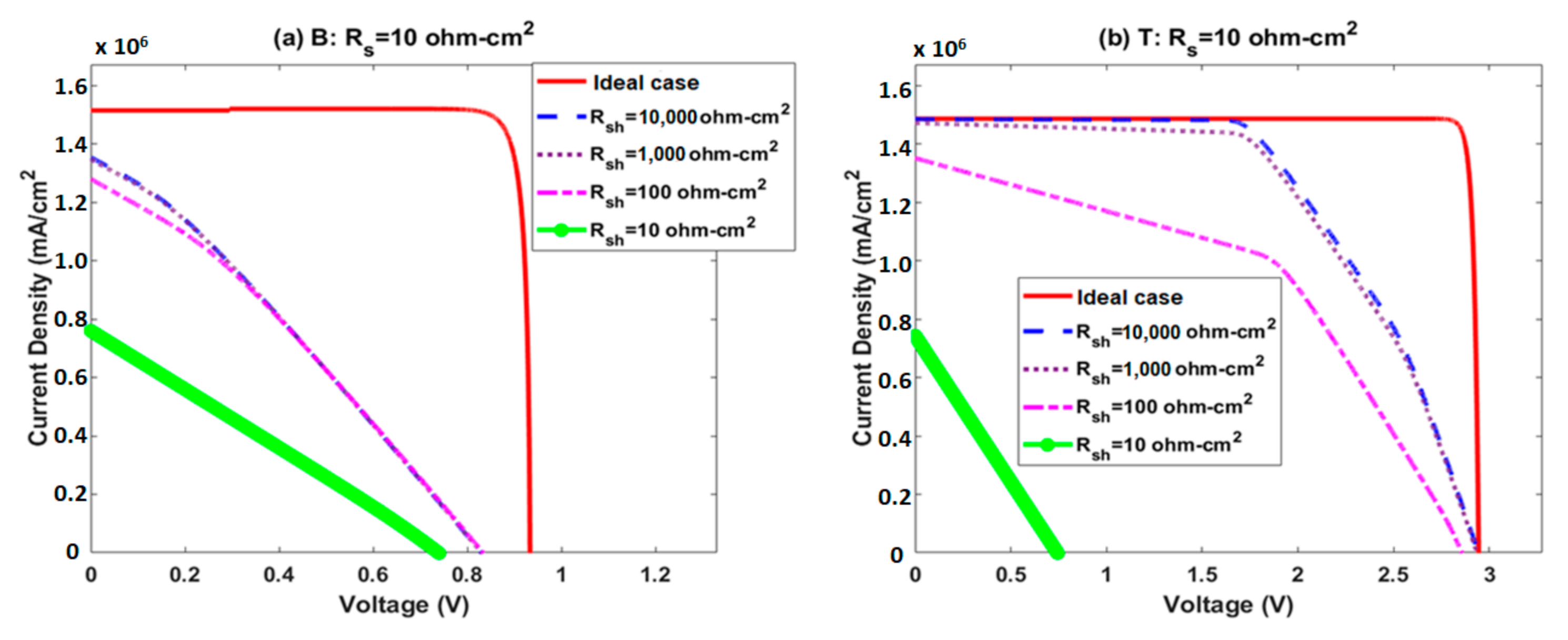In this section, the DBL of DJ IBTSC is presented to explain the theoretical results. First, we present the DBL of DJ IBTSC based on the theory of IBSC and tandem solar cells [
6,
7,
8,
12]. Subsequently, we divided two regions of a blackbody radiation spectrum and arranged the order of sub-bandgaps (E
CI, E
IV and E
CV (=E
g)) for each junction of the IBTSC. For this case, we assumed that the absorptivity of each carrier is ideally unity. However, the real-world IBSC has a low conversion efficiency due to low light absorption at the IB region. This can reduce the operating voltage range and experimental efficiency [
22]. Thus, we investigated the effect of light absorptivity variation at the IB and bulk region [
22]. Next, we considered the series and shunt resistance variations of the DJ IBTSC by a single diode PV model [
23,
24]. Finally, an alternative DJ IBTSC was suggested by replacing the bottom junction IBSC with a single junction solar cell to efficiently manage the incoming photon energies for each junction.
2.1. Detailed Balance of the Double-Junction Intermediate Band Tandem Solar Cells (DJ IBTSCs)
In this section, the operation of the DJ IBTSCs based on the DBL of IBSC and tandem solar cell principles is discussed [
11]. In
Figure 1, the incoming photon energy (E
ph(i)) is selectively absorbed by each junction (E
CI(i), E
IV(i), and E
CV(i) (i = 1, 2), where E
CI(i) denotes the energy between the conduction band (CB) and the IB, E
IV(i) denotes the energy between the IB and the valence band, and E
CV(i) denotes the energy between the CB and the valence band). This enables the generation of a two charge carrier at each junction of the IBTSC for the three possible carrier transitions that are denoted by CI (carrier transition from the CB to the IB), IV (carrier transition from the IB to the valence band (VB)), and CV (carrier transition from the VB to CB).
The solar spectrum was split into two regions (Tandem 1 and Tandem 2) for the DJ tandem solar cell operations (
Figure 2a). Each stack of the IBSC possessed three different bandgaps (E
g(i), E
IV(i), and E
CI(i)) that were organized within each region of the spectrum. The lower and upper ranges of the solar spectrum denote the bottom junction (IBSC1) and top junction (IBSC2) of the IBTSC, respectively (
Figure 2b).
We introduced E
hi(1) as the boundary point to organize the three sub-bandgaps of each region of the spectrum accurately; thus, we obtained the DBL limits of the IBTSC. The order of the bandgaps of the bottom junction (below E
hi(1)) was E
CI1 < E
IV1 < E
g1 < E
hi(1) while that of the top junction was E
CI2 < E
IV2 < E
g2. The overall bandgap sequence was E
CI1 < E
IV1 < E
g1<E
hi (1) < E
CI2 < E
IV2 < E
g2. E
g2 had to be three times higher than E
g1 for minimal operations. The detailed balance (DB) relations of the IBTSC are shown in Equations (1)–(5). Equations (1) and (2) show the generation rate and recombination rate, respectively, of the charge carriers in the IBSCs. In these equations the absorptivity was considered in order to describe the potential absorption of each carrier during each carrier transition. We discuss the impact of this in the next section.
where G is the generation rate, R is the recombination rate, f
S is a geometric factor (1/46,200). Conc is the optical concentration (1~46,200), where Conc = 1 and Conc = 46,200 denote 1 sun illumination and full illumination concentration (46,200 suns), respectively; h is the Planck’s constant, c is the speed of light, E
1 and E
2 are energy states, k is the Boltzmann’s constant (k = 1.38 × 10
−23 J/K), T
SUN is the temperature of the sun (6000 K), T
C is the ambient temperature (300 K), and µ is the chemical potential (q·V, where V is the operating voltage) and α
E2,E1 is the absorptivity (0 ≤ α
E2,E1 ≤ 1).
The current density (J) of the ith junction in the IBTSC is:
where subscript i denotes the number of junctions (i = 1 and 2 denote the bottom and top junctions, respectively), CV denotes the carrier transitions between the VB and CB, and CI denotes the carrier transitions between the IB and CB.
The optimal IB level was determined by the balance of the carrier transitions from (i) VB to IB and (ii) IB to CB. Since the IB was electrically isolated, there were no carrier extractions from the IB. (Equation (4)).
The chemical potential of each junction of the IBTSC is:
The equivalent circuit model describes an IBSC as two series-connected diodes possessing bandgaps of ECI and EIV, respectively, that are connected in parallel with a diode possessing a bandgap of ECV. The two series-connected diodes play a significant role in determining the open-circuit voltage (VOC).
The DB relations of each junction are described in
Table 1.
The independently connected (Ind) DJ IBTSCs have to satisfy Equation (5) due to the separately calculated maximum power points of each junction. In the series-connected (Ser) IBTSCs, each junction has to satisfy Equation (5) to function as an IBSC.
First of all, the calculated efficiency of Ind is shown Equation (6).
where σ is Stefan–Boltzmann constant (= 5.6704 × 10
−8 W∙m
−2∙K
−4), J
(i) (x) is the current density value at x volt and x is the arbitrary number.
However, the calculated efficiency of Ser DJ IBTSC was similar to that of conventional Ser tandem approaches. The junction with the lowest short circuit current density (J
SC) functioned as an IBSC at the optimal value of chemical potential (Equation (5)) and the corresponding current density at the maximum power point (J
m). The corresponding operating voltage (OV) at the other junctions was determined from the value of J
m. The top junction (IBSC2) possessed the lowest J
SC (
Figure 3); its OV was V
CV(2) (=2.78 V), and J
m was 1.466 × 10
6 mA/cm
2. The corresponding OV (V
(1) = 0.863 V) of the bottom junction was determined from J
m. Therefore, the overall OV was V
CV(2) + V
(1). The power was calculated as per the equations provided in
Table 2.
2.2. Impact of Absorptivity of Sub-Bandgaps on the DJ IBTSC
An important assumption in the idealized IBSC is that the incoming light is ideally absorbed into three sub-bandgap energies and upon absorption, each carrier transition is recombined. However, the recombination reduces V
OC even if the photo-generated current is enhanced by the IB region. In the actual implementation of the IBSC, the absorptivity of the IB region is low; therefore, it will require enhancement of the photo-generated current by introducing light-concentration, absorptivity improvement, and light trapping [
22]. In addition, the light absorptivity (= α
CV) of the host material (wide bandgap) must also be assessed based on the entire performance of the IBSC. We present two cases of absorptivity in
Figure 4a,b wherein (a) describes the low absorptivity 0 < α < 1 and (b) shows the ideal case of absorptivity (α = 1) of each carrier transition.
For this calculation, we assume that the absorptivity of each carrier transition is the same (0 ≤ α
CI = α
IV = α
CV ≤ 1) with a non-overlapping spectrum for each region. The related DBL equations are presented in Equations (1)–(5). Further, we used the optimal bandgaps (E
CI = 0.72 eV, E
IV = 1.25 and E
CV = 1.97 eV) at α = α
CI = α
IV = α
CV = 1 to simply explain and compare the variations of absorptivity with the efficiency changes. The results of this calculation are presented in
Figure 5a,b.
As show in
Figure 5, after applying the absorptivity variation to the DBL of an IBSC, we found that a theoretical maximum efficiency below α = 0.7 is the limit of the single junction (40.8% under blackbody radiation, see
Figure 5a,b). In this case, we found (i) the performance of IBSC behaves like a single junction solar cell, and (ii) each carrier transition is not effective due to the low absorption of sub-photon energies. In other words, the role of the IB degrades and ceases to function at α < 0.7 due to the considerable amount of recombination instances at the IB region. Therefore, absorption in IB is crucial to maintaining the performance of IBSC and its minimum absorptivity is 0.7 for efficient light absorption of each carrier transition.
2.3. Detailed Balance Limits (DBLs) of the DJ IBTSC and Impact of Resistance
A real-world tandem solar cell undergoes a change in charge conductivity which has a considerable impact on the series and shunt resistance. Therefore, in this section, we considered the single diode PV model to investigate the impact of series (R
s) and shunt (R
sh) resistance for each carrier transition (E
CI, E
IV and E
CV) in the DBL limit of a DJ IBTSC solar cell [
23,
24]. R
s is related to carrier collection and current flow between electron and hole contact, metal/semiconductor contact resistance, and metal resistance. Both the material quality and reverse saturation current determine R
sh due to the generation of current leakage current paths which determine the isolation of each junction [
23,
24]. Under consideration of both resistances in the DJ IBTSC, we investigated the effect on electrical parameters such as J
SC and V
OC through the analysis of current density and voltage curves.
For the single diode PV model of a solar cell, the related equation is shown in Equations (7) and (8).
where R
s is the series resistance, R
sh is the shunt resistance, J
0 is the reverse saturation current density, J
ph is the photo-generated current density, and J is the arbitrary current density.
The equivalent circuit model for an IBSC is shown in
Figure 6.
Figure 6 describes the PV diode model of each junction in the DJ IBTSC. Furthermore, Equations (7) and (8) are applied to each carrier transition of the three single diode models that are applied into a single junction in the DJ IBTSC. Overall, six diode models are utilized to calculate the resistance impact of DJ IBTSC.
